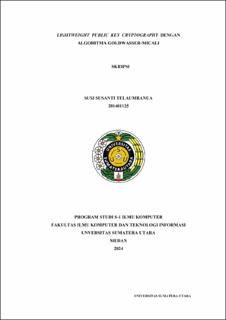Lightweight Public Key Cryptography dengan Algoritma Goldwasser-Micali
Lightweight Public Key Cryptography with The Goldwasser-Micali Algorithm

Date
2024Author
Telaumbanua, Susi Susanti
Advisor(s)
Budiman, Mohammad Andri
Herriyance
Metadata
Show full item recordAbstract
Electronic devices connected to the Internet of Things (IoT) which consist of devices that are connected to each other and have limited conditions and resources, allow sending data in real time. However, as the number of IoT devices increases, data attacks become easier. Data security on a device is very important to prevent irresponsible people from stealing or deleting information. For this reason, a special method is needed to ensure data security, namely cryptography. Cryptography is a technique for encoding data. This research uses the Goldwasser–Micali (GM) cryptographic algorithm. The security of the Goldwasser-Micali algorithm is determined by the complexity of the quadratic residual problem. In the Goldwasser-Micali (GM) encryption system, the public key consists of two components: a and N, while the secret key consists of N factorizations, namely the prime numbers p and q. However, finding the quadratic residue modulo a composite number is difficult, especially in the case where the factors of N are large prime numbers, . Goldwasser-Micali encryption offers semantic security, meaning an attacker cannot differentiate between the message and the encryption. This research carries out testing with the ESP32 microcontroller emulator based on Micropython. The results show that the Goldwasser-Micali algorithm is less effective for use in the Internet of Things because the performance decrease is less than 50% and the output in one minute has not yet appeared, in the prime digit range of 100.
Collections
- Undergraduate Theses [1253]
